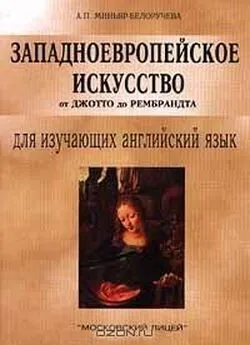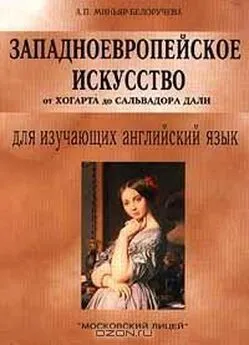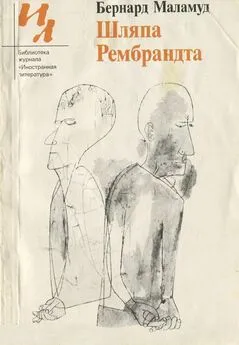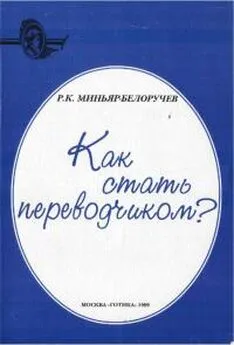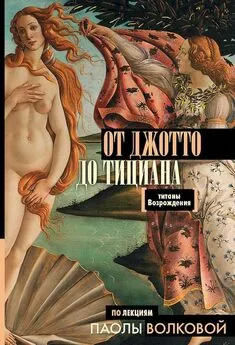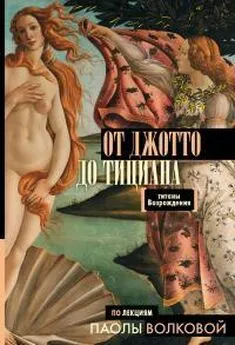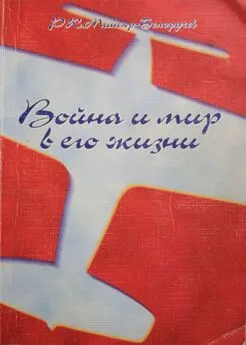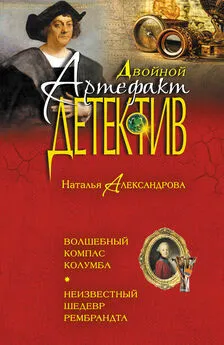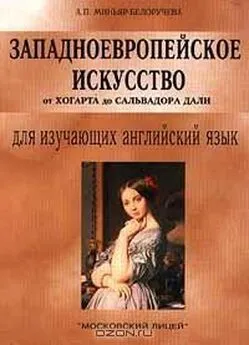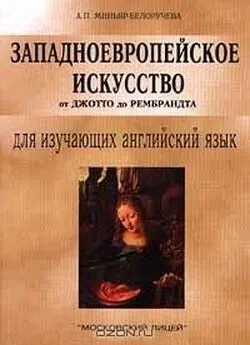А. Миньяр-Белоручева - Западноевропейское искусство от Джотто до Рембрандта
- Название:Западноевропейское искусство от Джотто до Рембрандта
- Автор:
- Жанр:
- Издательство:«Московский Лицей»
- Год:1999
- Город:Москва
- ISBN:5-7611-0181-5
- Рейтинг:
- Избранное:Добавить в избранное
-
Отзывы:
-
Ваша оценка:
А. Миньяр-Белоручева - Западноевропейское искусство от Джотто до Рембрандта краткое содержание
Тексты настоящего пособия охватывают пять веков западноевропейской живописи от Джотто до Рембрандта. Это дает возможность обучаемым приобрести не только лингвистические знания, усвоив обширный лексический материал, но и культурологические, поскольку последовательный хронологический переход текстов от одного художника к другому позволяет создать более или менее целостную картину развития западноевропейской искусства с XIII по XVII вв. Система упражнений направлена на усвоение лексического материала и развитие навыков устной речи.
Данная книга является первой частью цикла учебных пособий для изучающих английский язык и предназначена для студентов-искусствоведов, учащихся классических гимназий, лицеистов и всех интересующихся искусством.
Учебный центр «Московский Лицей»
пособие для изучающих английский язык
издание второе переработанное и дополненное
Москва -1999
Рецензенты:
И. И. Малинина кандидат филологических наук
Н. В. Васютина кандидат филологических наук
РЕКОМЕНДОВАНО кафедрой иностранных языков исторического факультета МГУ им. М. В. Ломоносова
Западноевропейское искусство от Джотто до Рембрандта - читать онлайн бесплатно полную версию (весь текст целиком)
Интервал:
Закладка:
The warmth of Hals's early style is seen in The Laughing Cavalier . The date 1624 and the subject's age 26 are inscribed in the background, and since the Cavalier's diagonal shadow also falls on it, it is clearly a wall. The Caravaggesque nowhere is thus converted into a definite here. The wall is irradiated with light and seems insubstantial. The armours proclivities of the young man are indicated by the arrows, torches and bees of Cupid and the winged staff and hat of Mercury embroidered in red, silver and gold on the dark brown of his slashed sleeve, with his glowing complexion, dangerous moustaches, snowy ruff and dashing hat, the subject is the symbol of Baroque gallantry. The climax of the painting is the taunting smile on which every compositional force converges.
The opposite of this glittering portrait is the sombre Malle Babbe , of about 1630-33. Nobody knows who the old creature was or the meaning of her nickname. Often called an «old crone» she might be from forty to sixty years old. Hals has caught her in the midst of a fit of insane laughter. Possibly she is a town idiot and the owl on her shoulder is a symbol of foolishness. The expression seized in a storm of strokes is rendered with a demonic intensity.
About 1664 when he was past 80, Hals showed a still different side of his character and ability in the Regentesses of the Old Man's Almshouse . Painted almost entirely in black and white and shades of grey, this solemn picture is united by diagonal movements. The painter had only devastated faces and white collars of the women as component elements. Each of the subjects has reacted in a separate way to age and experience, yet all participate in a calm acceptance of the effects of time. In its simplicity the composition shows an expressive depth unexpected in the generally excited Hals.
Make sure you know how to pronounce the following words:
Hals; Haarlem; Antwerp; cavalier; banquet; regentess
Banquet of the Officers of the Saint George Guard Company – «Портрет офицеров гильдии святого Георгия»
The Laughing Cavalier – «Портрет молодого офицера»
Malle Babbe – «Мале Бабе»
Regentesses of the Old Man's Almshouse – «Регентши приюта для престарелых»
I. Read the text. Mark the following statements true or false
1. Today Hals is recognized as the most brilliant portraitist.
2. Hals shows citizen-soldiers in the midst of the banquets.
3. Malle Babbe is a glittering portrait.
4. The warmth of Hals's early style is seen in the Regentesses of the Old Man's Almshouse .
5. The Laughing Cavalier is the symbol of Baroque gallantry.
6. The subjects of the Regentesses of the Old Man's Almshouse participate in a calm acceptance of the effects of time.
II. How well have you read? Can you answer the following questions?
1. What gift was Hals blessed with?
2. What were Hals's early commissions? Why were not Hals's portraits conductive to imaginative painting? How did Hals's predecessors compose their group portraits? Who could raise group portraits to a level of high drama?
3. What is the Banquet of the Officers of the Saint George Guard Company noted for? What has Hals pictured in this work of art? What ties the picture together?
4. Where is the warmth of Hals's early style seen? How old is the subject? What makes the subject the symbol of Baroque gallantry? How did Hals interpret the Caravaggesque nowhere?
5. What is the opposite of The Laughing Cavalier ? When was it painted? Whom has Hals depicted in it?
6. In what painting did Hals show a different side of his character? How old was he at that time? What did the painter show in this work?
III. I. Give Russian equivalents of the following phrases:
to catch the individual in a moment of action; group portraits in alignments; unerring strokes; a moment of perception; to be blessed with the gift; effects of time; to radiate one's self-confidence; Caravaggesque nowhere; a slashed sleeve; sketchy brushstrokes; armours proclivities; a taunting smile; to be irradiated with light; snowy ruff; a dashing hat; devastated faces; to be conductive to; the predecessors of the painter; show the citizen-soldiers in the midst of the banquets; to raise the portraits to a level of high drama; to tie the picture together; a glittering portrait; militia companies; a solemn picture; component elements.
II. Give English equivalents of the following phrases:
опустошенные лица; быть наделенным даром; широкие мазки; сияющий портрет; лихо заломленная шляпа; круглый плоеный жесткий воротник; стрелковые гильдии; предшественники художника; след времени; полные, средних лет мужчины; связать картину воедино; насмешливая улыбка; изображать стрельцов в разгар веселого застолья; склонность к военному искусству; сиять самоуверенностью; групповой портрет, построенных в шеренгу людей; рукав с разрезами; эскизная манера письма; поздний период творчества; поднять на уровень драмы.
III. Make up sentences of your own with the given phrases.
IV. Arrange the following in the pairs of synonyms:
a) strokes; radiate; traditional; indicate; predecessor;
b) conventional; precursor; brushwork; shimmer; show.
IV. Here are descriptions of some of Hals's works of art. Match them up to the given titles.
1. The model was caught in the midst of a fit of insane laughter.
2. The painter had only devastated faces and white collars of the figures as component elements.
3. The climax of the painting is the taunting smile.
4. Broad brushstrokes indicate the passage of light on colour with a flash and sparkle unknown even to Rubens.
a. The Laughing Cavalier
b. Banquet of the Officers of the Saint George Guard Company
c. Regentesses of the Old Man's Almshouse
d. Malle Babbe
V. Translate the text into English.
Франс Халс – крупнейший портретист Голландии XVII в. Халс написал серию групповых портретов. Это в основном изображения членов добровольных стрелковых гильдий города Гарлема. «Портрет офицеров гильдии святого Георга» (1616) является одним из лучших. Яркие краски, непринужденное расположение фигур – нравились современникам Халса. С полотен смотрят плотные, уверенные в своих силах люди средних лет. Халс изображает их обычно в товарищеской пирушке. Групповые портреты Халса – одно из высших достижений голландской живописи.
Индивидуальные портреты Халса носят черты жанровой картины. Лучшим примером этого является портрет старухи, «гарлемной ведьмы», Малле Баббе, с совой на плече. Эскизная манера была типична для Халса. Незадолго до смерти Халс написал два групповых портрета обитателей приюта для престарелых, в одном из которых он окончил свои дни. На портретах изображены старые люди, покорившиеся времени. Монохромный колорит портретов создает особый трагизм, подчеркивая драматизм судьбы самого больного, одинокого и нищего художника, создавшего свои самые драматические произведения на девятом десятке жизни.
Искусство Халса имело большое значение для развития портрета, бытового жанра, пейзажа и натюрморта в целом.
VI. Summarize the text.
Vll. Topics for discussion.
1. Hals's style and characters.
2. Hals's artistic achievements.
Unit XVI Rembrandt (1608-1669)
Rembrandt van Rijn is the greatest Dutch master, one of the supreme geniuses in the history of art. To this day the art of Rembrandt remains one of the most profound witnesses of the progress of the soul in its earthly pilgrimage toward the realization of a higher destiny. The son of a prosperous miller, Rembrandt was born in Leiden in 1608. He was trained as a painter by two minor local artists. His rapid success promoted him to move to Amsterdam in 1631.
In 1632 Rembrandt's worldly success was assured. He had more commissions and pupils than he could accept. He married Suskia van Uylenburg, the lovely daughter of a wealthy family. He bought a splendid house, started a collection of paintings and rarities.
The universal artist dealt with many world subjects. Rembrandt painted, engraved and drew more than eighty self-portraits. Rembrandt was a master of portraiture. He created around fifty portraits.
The best group portraits painted by Rembrandt are the Anatomy Lesson of Dr. Tulp , of 1632, and The Night Watch , of 1642. In the former Rembrandt has not only painted faces, beards and lace ruffles, he has given the composition a new drama. Mystery dominates in his painting, reminding the living of their own inevitable destiny. As for The Night Watch , the members of the Company of Captain F. B. Cocq were dissatisfied with the colossal group portrait. The subject of the painting is the formation of the militia company for a parade. Through wonderful effective lightning Rembrandt has turned a narrative prose into a dramatic poetry. Real events are submerged in the symphonic tide of the colouring. All the men paid equally to have themselves depicted, yet some are sunk in a shadow, one man is concealed except for his eyes. It was inevitable that Rembrandt would lose popularity as a portrait painter, although not at once.
In Amsterdam Rembrandt began to paint in a highly imaginative Baroque style. He was influenced by Caravaggio's sharp light-and-dark contrasts and by Rubens's spiral compositions. A brilliant example of this is the Angel Leaving Tobit and Tobias , of 1637. Rembrandt has followed the book of Tobit available to him as a source in the Apocrypha. The formerly blind Tobit cured by the Archangel Raphael, prostrates himself in gratitude, while his son Tobias looks upward in wonder at the departing figure. Seen sharply from the back the angel is taken from the sight into an open cloud in a flash of light. Along with luminary effects goes a new technical freedom. The smooth, detailed early manner is gone. The forms are quickly sketched.
In 1642 Saskia died. Rembrandt's commissions slackened off as a result of his unconventional painting. In 1655 Rembrandt found himself in the midst of several financial troubles. At that period he painted The Polish Rider . The precise meaning of this painting has not been determined. Probably it is an allegory of the man's earthly journey, its many dangers and uncertain destination. In the grim and rocky valley a pool can be seen. Against the dark hill there is a hut. Near the crest there is a ruined castle. The youth rides in light, alert, with his weapons at ready. The figure and his horse stand forth in a new sculptural grandeur, intensified by the fact that many of the impastos have been laid on with a palette knife. The artist carved the pigments, especially in the dark rocks and the bony forms of the horse.
Читать дальшеИнтервал:
Закладка:
